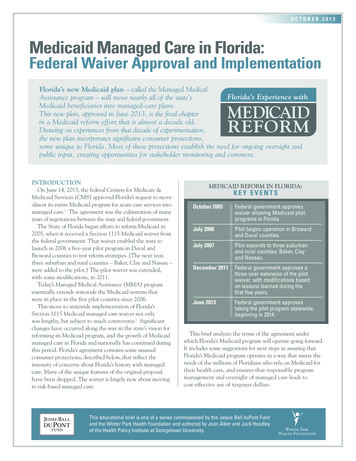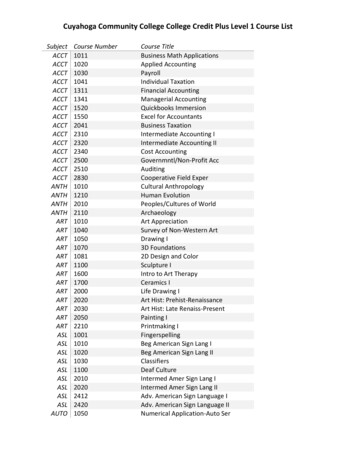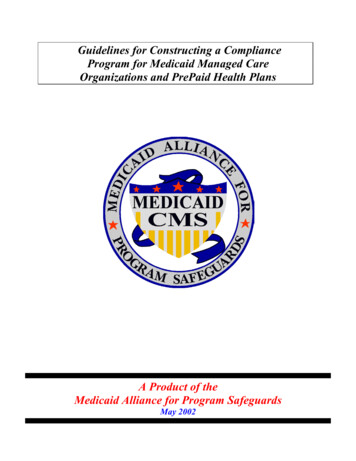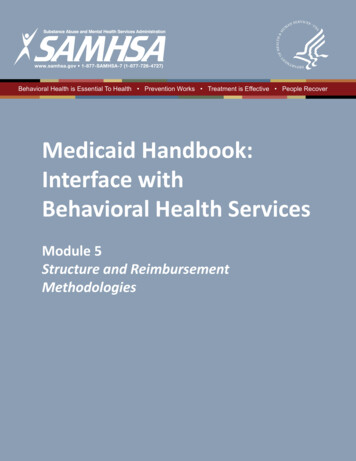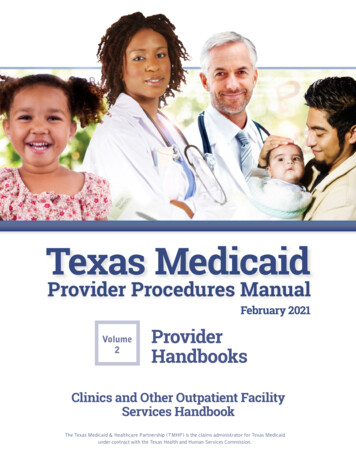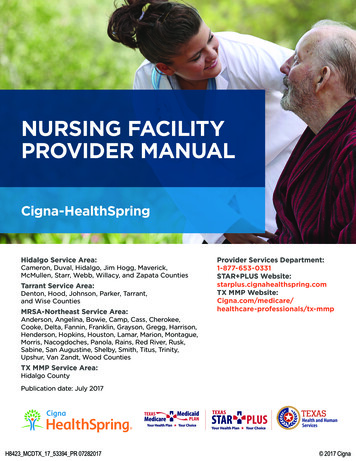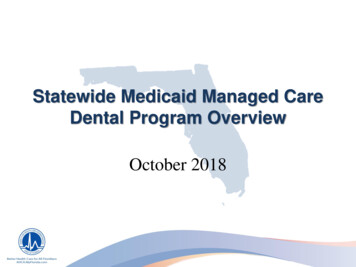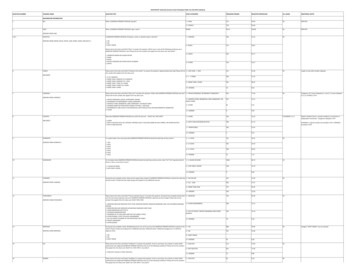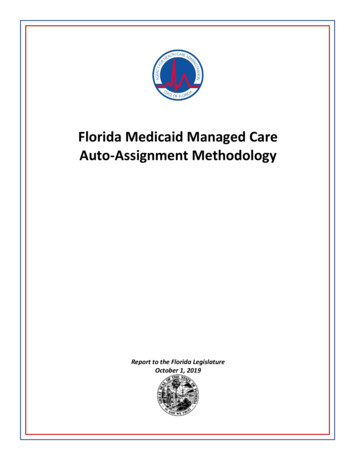
Transcription
Florida Medicaid Managed CareAuto-Assignment MethodologyReport to the Florida LegislatureOctober 1, 2019
Table of ContentsTable of Contents . 2Executive Summary. 3Purpose of the Report. 4Section I: Statutory Basis for Enrollment . 4Section II: Enrollment Process Overview . 6Section III: 2018-2023 SMMC Health Plan Re-Procurement. 7Individuals Were Assigned to the Plan They Were In . 7Combining Managed Medical Assistance and Long-Term Care (LTC) Plans . 7Minimum and Maximum Plans in Regional Procurement . 8Section IV: Implementation of the 2018-2023 SMMC Contracts . 10Analysis of the Implementation Enrollment Process . 11Unique LTC Enrollment Considerations . 12Summary of Implementation Enrollment Impact . 12Section V: SMMC Auto-Assignment Post Procurement (Standard Operating Protocol) . 12Analysis of the Post-Procurement Auto-Assignment Methodology . 13Section VI: Stakeholder Feedback on the Auto-Assignment Methodology . 14Section VII: Auto-Assignment Methodology Options . 15Section VIII: Conclusion . 17Appendix I . 18Appendix II . 2110/1/20192
Executive SummaryDuring the 2019 legislative session, language in the General Appropriations Act directed theAgency for Health Care Administration (Agency) to develop an alternative automatic assignmentmethodology for Medicaid recipients enrolled in the Statewide Medicaid Managed Careprogram.The Agency for Health Care Administration is directed to develop an alternative automaticassignment methodology for Medicaid recipients enrolled in the Medicaid Managed Careprogram, pursuant to s.409.969(1), Florida Statutes. The alternative auto assignmentmethodology shall ensure that all managed care organizations in the Managed MedicalAssistance program and the Long Term Care Managed Care program receive equitabletreatment in the automatic assignments of new and reassigned enrollees. Equitabletreatment means the number of assignments does not systematically prevent new plansfrom establishing successful operations within the program. The agency shall submit areport describing current automatic enrollment procedures and criteria, assessing theeffects of those policies and procedures, evaluating options for modifying currentpractices, and recommending a new methodology. The report is to be submitted to thePresident of the Senate and Speaker of the House of Representatives no later thanOctober 1, 2019. Implementation of the redesign is contingent on legislative approval.The Agency has historically assigned Medicaid recipients into managed care plans based on:1. The individual’s choice of plan2. Statutory mandates on assignment to plans3. The principle that individuals’ continuity of care is of paramount importanceThis report explains how plan assignments are made using person-centered principles bothwhen Statewide Medicaid Managed Care plans are re-procured and on an ongoing basis andthe impact of the different steps on the number of individuals available to be assigned to plans.The Agency issued a Request for Information (RFI) to solicit feedback on this report. Therespondents were all Medicaid plans. When the Agency asked how the auto-assignmentmethodology should be designed to ensure an equitable distribution of enrollees, there were twothemes that emerged; Open Competition and Guaranteed Enrollment.This report provides those two options for consideration when designing a methodology for theauto-assignment algorithm for both future procurements and day-to-day operations. The optionscan be supplemented with a variety of considerations, such as aligning Medicare enrollment andassigning to a specialty plan where applicable.10/1/20193
Purpose of the ReportThis report fulfills a requirement from the 2019 legislative session when language in the GeneralAppropriations Act directed the Agency for Health Care Administration (Agency) to develop analternative automatic assignment methodology for Medicaid recipients enrolled in the StatewideMedicaid Managed Care program. Specifically:The Agency for Health Care Administration is directed to develop an alternative automaticassignment methodology for Medicaid recipients enrolled in the Medicaid Managed Careprogram, pursuant to s.409.969(1), Florida Statutes. The alternative auto assignmentmethodology shall ensure that all managed care organizations in the Managed MedicalAssistance program and the Long Term Care Managed Care program receive equitabletreatment in the automatic assignments of new and reassigned enrollees. Equitabletreatment means the number of assignments does not systematically prevent new plansfrom establishing successful operations within the program. The agency shall submit areport describing current automatic enrollment procedures and criteria, assessing theeffects of those policies and procedures, evaluating options for modifying currentpractices, and recommending a new methodology. The report is to be submitted to thePresident of the Senate and Speaker of the House of Representatives no later thanOctober 1, 2019. Implementation of the redesign is contingent on legislative approval.Section I: Statutory Basis for EnrollmentIn 2013 and 2014, the Agency implemented a Statewide Medicaid Managed Care (SMMC)program pursuant to Chapter 409, Part IV, Florida Statutes. In accordance with the statute,contracts were recently re-procured, resulting in contracts awarded for the period of 2018-2023.The SMMC program consists of two main components, the Managed Medical Assistancecomponent and the Long-Term Care component, and a stand-alone Dental component. Thevast majority of full-benefit Medicaid recipients are required to enroll in the MMA component ofthe program. Nearly 3 million of the 3.8 million Florida Medicaid recipients are enrolled, withmost of those not enrolled consisting of limited benefit groups such as those who only qualify forMedicaid to pay Medicare cost-sharing; medically needy who qualify on a month-to-monthbasis; and those with other insurance coverage. All recipients seeking to receive long-term careservices from the Florida Medicaid program must enroll in the Long-Term Care component ofthe SMMC program, with the exception of those in certain institutions and those enrolled in adifferent 1915(c) home and community-based services waiver.Florida Statute provides direction to the Agency on how to enroll people into the health plansparticipating in the program. Specifically, 409.977, F.S. and 409.984, F.S., direct the Agency to“automatically enroll into a managed care plan those Medicaid recipients who do not voluntarilychoose a plan pursuant to s. 409.969.” Enrollees are guaranteed a choice of plans and, if nochoice is made, are assigned based on an algorithm which takes into consideration statutoryrequirements for a preference for Specialty plans and Medicare plans. Details of the statutoryprovisions are in the chart below.10/1/20194
Specific Statutory Direction Regarding How to Enroll a Recipient Into a Health PlanThe Long-Term Care ComponentThe Managed Medical Assistance(409.984 (1) & (2)Component (409.977 (1) & (2)409.977 (1): The agency shall automaticallyenroll into a managed care plan thoseMedicaid recipients who do not voluntarilychoose a plan pursuant to s. nsiderations georgraphic409.984 (1): (1) The agency shallautomatically enroll into a long-term caremanaged care plan those Medicaid recipientswho do not voluntarily choose a plan pursuantto s. 409.969.(2) When automatically enrolling recipients in (2) When automatically enrolling recipients inmanaged care plans, the agency shallplans, the agency shall take into account theautomatically enroll based on the followingfollowing criteria:criteria:(a) Whether the plan has sufficient network(a) Whether the plan has sufficient network capacity to meet the needs of the recipients.capacity to meet the needs of the recipients. (b) Whether the recipient has previously(b) Whether the recipient has previouslyreceived services from one of the plan’s homereceived services from one of the plan’sand community-based service providers.primary care providers.(c) Whether the home and community-based(c) Whether primary care providers in oneproviders in one plan are more geographicallyplan are more geographically accessible to the accessible to the recipient’s residence thanrecipient’s residence than those in other plans. those in other plans.When a specialty plan is available toaccommodate a specific condition ordiagnosis of a recipient, the agency shallassign the recipient to that plan.The agency shall automatically enrollrecipients in plans that meet or exceed theperformance or quality standards establishedSpecialQuality andConsiderations Performance pursuant to s. 409.967SpecialtyPlan andSpecialConsiderations conditionProhibitionsProhibitionsPoor Quality The agency . . may not automatically enrollrecipients in a plan that is deficient in thoseandPerformance performance or quality standards [s. 409.967].Except as otherwise provided in this part, theNo other plan agency may not engage in practices that aredesigned to favor one managed care plan overperferenceanother.allowed10/1/2019If a recipient is deemed dually eligible forMedicaid and Medicare services and iscurrently receiving Medicare services from anentity qualified under 42 C.F.R. part 422 as aMedicare Advantage Preferred ProviderOrganization, Medicare Advantage Providersponsored Organization, or MedicareAdvantage Special Needs Plan, the agencyshall automatically enroll the recipient in suchplan for Medicaid services if the plan iscurrently participating in the long-term caremanaged care program.The agency shall automatically enrollrecipients in plans that meet or exceed theperformance or quality standards establishedpursuant to s. 409.967The agency . . may not automatically enrollrecipients in a plan that is deficient in thoseperformance or quality standards [s. 409.967].Except as otherwise provided in this part, theagency may not engage in practices that aredesigned to favor one managed care plan overanother.5
Section II: Enrollment Process OverviewThe enrollment algorithm employed by the Agency is based on these statutory provisions andthe core principle that the continuity of care for the Medicaid recipient should always be ofprimary consideration. This person-centered approach includes enrolling recipients into plansas family groups, when possible, and re-enrolling individuals into plans with which they had aprevious enrollment.When individuals apply for Medicaid, the Department of Children and Families (DCF) sends anightly application file to the Florida Medicaid Management Information System (FMMIS), whichin turn sends the file to the Agency’s enrollment broker’s system to create records for eachindividual applicant. (Some individual are eligible for Medicaid due to their federal SupplementalSecurity Income (SSI) eligibility. For these SSI eligible individuals, the federal State DataExchange sends a nightly file to the FMMIS, which is transmitted to the Agency’s enrollmentbroker’s system for the creation of an individual record for each eligible individual.)At the time of application to DCF, individuals may choose an SMMC plan immediately followingthe completion of the application through the Statewide Medicaid Managed Care website. If noplan choice is made at that time, individuals may later make a plan choice through the Agency’senrollment broker either through the on-line member portal or by calling and speaking with achoice counselor. Once an individual is determined eligible, DCF sends an eligibility update fileto the FMMIS for processing. After processing is complete, FMMIS sends an eligibility updatefile to the enrollment broker system for managed care enrollment. The enrollment brokerdetermines whether the individual has made a choice of plans and, if not, runs the autoassignment process to select a health plan for the person. It then generates a letter that tells theperson the plan they have chosen or been assigned to and mails a “welcome packet” thatincludes the letter, information about other plans available in the person’s region, and how tochoose a different plan if desired. The letter informs them that if they are satisfied with the planassignment, no action is needed, and provides information on the actions needed in order toselect a different plan.SMMC enrollment and assignment consists of the following processes. The enrollment systemlooks at each of these in this order:1. Reinstatement: Reinstatement is applicable to recipients enrolled in managed care wholose Medicaid eligibility for less than 180 days and then regain it. Recipients eligible forreinstatement are enrolled in the last plan in which they were enrolled. (Specialty planshave specific eligibility requirements such as age; if recipients no longer meet thoserequirements, they will not be enrolled in their prior plan.)2. Recipient Choice: If the recipient is not eligible for reinstatement, the system evaluatesif the recipient has made a choice of plans. If the recipient chose a plan, they areenrolled with that plan.3. Auto Assignment: If the recipient is not eligible for reinstatement and did not make achoice of plan, the recipient is assigned to a plan by the auto-assignment process.Enrollment occurs after each step of the auto assignment process in which the recipientmeets the criteria of that step. If auto assignment occurs, the recipient will receive aletter outlining their plan assignment and how to choose a different plan, if they wish.a. Newborn: Parents who are enrolled in Medicaid may select a plan for anewborn prior to the child being born. Recipients who are born without a plan10/1/20196
choice on file are assigned to their mother’s plan if they are eligible to enroll inthat plan. If not, they are assigned based on the auto-assignment algorithm.This report focuses only on the third enrollment process outlined above, the auto-assignmentprocess. The other enrollment processes listed are not included in this report.Section III: 2018-2023 SMMC Health Plan Re-ProcurementDuring Fiscal Year 2018-19 the Agency re-procured the SMMC health plans for the next 5-yearperiod (2018-2023). There are a number of factors specific to the procurement that impactedhow recipients were distributed across plans. Many of these factors are specified in Floridalaw, and others are based on decisions made by the Agency based on person-centeredprinciples. This section details those factors that impact enrollment into plans.Individuals Were Assigned to the Plan They Were InPursuant to the terms of the Invitation to Negotiate used to procure the new SMMC contracts,and in alignment with the core principle of continuity of care, most recipients enrolled inexisting plans were automatically assigned to those plans if those plans were awarded a newcontract. If a recipient has previously made a choice/ been enrolled with a plan and wassatisfied with that plan, no action should have to be taken on the recipient’s part to continuewith that plan. Recipients who had previously enrolled in two separate plans for their MMAand LTC services were assigned to one Comprehensive or LTC Plus plan for those services,and therefore may have experienced a plan change.Combining Managed Medical Assistance and Long-Term Care (LTC) PlansFor the original SMMC program procurement, the Agency was required to first procure plansfor the LTC program component and then to subsequently procure plans for the MMA programcomponent. The Agency therefore conducted two separate procurements, one for eachprogram component. This resulted in most recipients who needed both MMA and LTC servicesbeing enrolled in separate MMA and LTC plans. In the new contract period, the LTC and MMAprogram components were procured simultaneously, and, as a result, any enrollee whorequires both LTC and MMA services receives all of their Medicaid services from one SMMCplan. The chart below displays the different plan types that were awarded a contract in 2018.10/1/20197
Minimum and Maximum Plans in Regional ProcurementFlorida law requires that SMMC plans be procured by the 11 Agency regions. This impacts thenumber of plans that are awarded contracts and therefore the number of members per plan.Florida Statutes outline the minimum and maximum number of plans the Agency can award inthe SMMC procurement process. The Agency awarded the maximum number of health plancontracts allowed per ss. 409.974 and 409.981, F.S., in each region.In the original SMMC program there were a total of 17 health plans throughout the state. Therewere two health plans that participated in the original SMMC program that were not awardedany regional contracts in the new SMMC program, and there were four brand new plans thatwere awarded contracts to participate in the Medicaid program for the first time. Several plansparticipating in the original SMMC program either won or lost contracts in certain Regions. Inevery Region there were changes to the plans that participate. This included: Plans exiting the Region because they were not awarded a contract, orPlans new to a Region because they were:1. Brand new plans that had not participated in SMMC during the initial five-yearcontract period, or,2. Plans that had participated during the initial five-year contact period, but in adifferent Region.The chart below details the plans that left regions, stayed in regions, or were brand-new to aregion.10/1/20198
The Agency awarded contracts to at least some of the incumbents in each region. A limitednumber of plans exited the regions. In some cases, no MMA (non-Specialty) plans or LTCplans exited a region.An additional factor affecting the number of plans was a merger of three different health plansduring the procurement of the new contracts. Anthem d/b/a Amerigroup purchased two healthplans, Better Health and Simply, and bid as one consolidated entity for the new contract. TheAgency awarded new SMMC contracts in regions where the consolidation of Amerigroup,Better and Simply opened up room for a new plan award when all of the incumbent plans andthe surviving entity were awarded a contract.In a situation where the Agency awarded new plan contracts where there were no exitingplans, the result was that there were no recipients to distribute to new plans because none ofthe recipients in the region were enrolled in an exiting plan.Some regions had a significant number of plans that were awarded new contracts, and thisreduced the pool of recipients available to be assigned to new plans entering the region. Insome cases, most recipients were enrolled in continuing plans, and therefore the recipient poolavailable for assignment was small.10/1/20199
The chart below demonstrates the number of recipients by region who were enrolled in exitingplans and therefore were in the pool of recipients who could be assigned through the autoassignment process. In MMA, Region 10 had the lowest number of individuals in exiting plansat 7,371, and Region 7 had the largest number at 112,836. Even in Region 7, however, thisrepresented only 28 percent of the total MMA enrollee population for the region. In LTC,Regions 1, 3, 4, 10, and 11 did not have any individuals in exiting plans. (Note: The numberswere run at a point in time during implementation and as enrollment fluctuates each day, thenumbers could vary if rerun today.)ProgramDisplay NameMMAFreedom Health [Specialty Plan]Region 1 Region 2 Region 3 Region 4 Region 5 Region 6 Region 7 Region 8 Region 9 Region 10 Region 114,374Magellan Complete Care [Specialty Plan]Molina 312612,808827,04225,61931,12036,34650,863United HealthcareTotal 14,416Total Region 85405,603203,081267,676257,982487,759Percent of 2%22.99%28.56%2.86%2.96%25,812Aetna Better Health1,333Molina Healthcare1,3321,655United Healthcare2,2571,6781,9309431,170Total 766,5419,9428,8900% 28.33% 13.66% 20.15% 14.42% 25.18%0%0%Total PopulationPercent of PopulationGrand TotalPercent of Total SMMC Population3,2533,6747,7280% .79%2.39%3.78%1.50%2.60%0.24%0.48%Section IV: Implementation of the 2018-2023 SMMC ContractsThe Agency transitioned to the new contracts by splitting the state into three geographical areasand implementing one area per month from December 2018 through February 2019. Theprocess for recipient enrollment into awarded health plans was outlined in the SMMC HealthPlan Procurement. The Agency did not receive any protests related to this specification fromany plan in any region as part of the SMMC procurement process. The goal of the 2018-2023SMMC Plan Procurement Implementation was that Medicaid recipients would continue toreceive their services from their current providers if possible. This goal shaped theimplementation and enrollment processes the Agency followed.Agency priorities during implementation included ensuring Medicaid recipients had theopportunity to enroll in the plan of their choice:1. Recipients were sent a letter with a brochure that included all the available health plansin the region, including extra benefits each plan offered, 15-45 days in advance of theirregion go-live. The letter included the plan assignment and effective date for eachrecipient and their family members if they did not take action and choose a different plan.2. Recipients were given 120 days after enrollment to choose the plan of their choice.The Agency used an auto-assignment methodology that can be grouped into five high levelcomponents for assessing each recipient for assignment into a Medicaid health plan. The highlevel components include:10/1/201910
1. Recipient Existing Plan Relationship- Recipients who had additional insurance coveragefrom a related plan, such as Medicare Advantage, or who were already enrolled with anincumbent Medicaid health plan. This included recipients who were in different LongTerm Care and Managed Medical Assistance plans that needed to be aligned to oneplan for all of their Medicaid services.2. Specialty Plan Eligibility (MMA only)- Recipients eligible for a Specialty plan based onage, diagnosis, or condition were assigned to the appropriate Specialty plan. This is arequirement of Florida Statutes.3. Family Member Already in a Medicaid Plan- If a family member was already enrolledwith an incumbent Medicaid health plan, individuals were enrolled in that plan.4. New Plan Base Enrollment (MMA only)- If a Region had exiting plans, the Agencyassigned 20%-30% of the exiting plan recipients to new plans before the remainder ofthe exiting plan population was distributed in the Round Robin step.5. Round Robin Distribution- If a recipient was not assigned based on the groups above,they were distributed by family group in turn to each plan in each Region.Analysis of the Implementation Enrollment ProcessThe following chart displays the outcome of the auto-assignment methodology described aboveat a statewide level. It shows that during the implementation about 83% of MMA recipients and93% of LTC recipients were assigned to their plan because of their relationship with theirincumbent Medicaid plan.10/1/201911
Unique LTC Enrollment ConsiderationsSome LTC recipients whose plan was exiting a region were assigned to the Medicare Plan theywere already enrolled with based on statutory direction. This requirement drove LTC enrollmentinto Medicaid plans that were also Medicare plans in the state.In the original SMMC program, recipients who received LTC services could be enrolled in twodifferent plans for LTC services and MMA services. During the implementation of the newcontracts, if a recipient who was enrolled in an LTC plan that was exiting was also enrolled in aMMA plan that was awarded a new contract, the Agency assigned them to their MMA plan forboth LTC and MMA services for the new contract period. This is in line with person-centeredprinciples that the recipient should not have to change plans unnecessarily.While the person-centered approach to aligning all services for Medicaid recipients in one healthplan was the right thing to do for the recipient, the impact to the new LTC plan was significant.Instead of a statewide pool of 12,298 recipients available for distribution to Comprehensiveplans and the LTC plan in the round robin step, the available statewide pool of recipients was7,455.Summary of Implementation Enrollment ImpactIn order to support the Agency’s goal for the 2018-2023 SMMC Health Plan Implementation ofrespecting Medicaid recipient’s health care choices and ensuring that they could seamlesslycontinue to receive their services, the enrollment process for the new contracts was designed toensure that most recipients had continued access to their current providers, as required by s.409.977(2), F.S. and s.409.984(2), F.S. Without knowing how many new plans by plan typewould be awarded a contract, what the impact of the Anthem/ Simply acquisition would be, andhow many incumbent plans would bid for a comprehensive contract and win, the Agency couldnot have predicted the impact of the enrollment process on new plans.A regional market-share comparison of the Medicaid plans enrollment before and after theSMMC contract implementation is attached in Appendix I.Section V: SMMC Auto-Assignment Post Procurement (StandardOperating Protocol)When a person applies for Medicaid eligibility they are given the opportunity to choose whichMedicaid health plan they would like to enroll in if they are determined eligible for Medicaid. Ifthey are determined eligible the Agency will enroll them into the health plan they initially choseduring the application process. If they do not have a health plan choice on file, the Agency runsthem through the daily auto-assignment process. After they are enrolled into a Medicaid healthplan, they have 120 days to pick another plan. After the 120 days passes, the recipient is lockedinto their health plan until their next open enrollment period, unless they meet a good causereason to change plans, as detailed in 59G-8.600, Florida Administrative Code.During the open enrollment period each year all recipients have a choice of every Medicaid planin their region for which they qualify. The open enrollment period lasts 60 days. The Agencysends letters and brochures that contain plan specific information to each recipient 30 daysbefore their open enrollment period.10/1/201912
When recipients do not choose a plan, the Agency uses an auto-assignment methodology thatcan be grouped into four high level components when assessing each person for assignmentinto a Medicaid health plan. The high-level components include:1. Recipient Existing Plan Relationship- Recipients who had additional insurance coveragefrom a related plan, such as Medicare Advantage, or who were already enrolled with anincumbent Medicaid health plan.2. Specialty Plan Eligibility (MMA only)- Recipients eligible for a Specialty plan based onage, diagnosis, or condition were assigned to the appropriate Specialty plan. This is arequirement of Florida Statutes.3. Family Member Already in a Medicaid Plan- If a family member was already enrolledwith an incumbent Medicaid health plan, individuals were enrolled in that plan.4. Round Robin Distribution- If a recipient was not assigned based on the groups abovethey were distributed by family group in turn to each plan in each Region.Analysis of the Post-Procurement Auto-Assignment MethodologyThe chart below displays the statewide auto-assignment enrollment data for distribution to LTCand MMA plans using the 4 components noted above from March 2019- August 2019 (afterSMMC Health Plan Procurement Implementation). A regional breakout that includes eachregion and health plan is attached in Appendix II.About half of the auto-assignment enrollments for both MMA and LTC occur in components 1-3and ab
Florida Medicaid Managed Care . Auto-Assignment Methodology . Report to the Florida Legislature . October 1, 2019 . 10/1/2019 2 . . Florida Statute provides direction to the Agency on how to enroll people into the health plans participating in the program. Specifically, 409.977, F.S. and 409.984, F.S., direct the Agency to .
